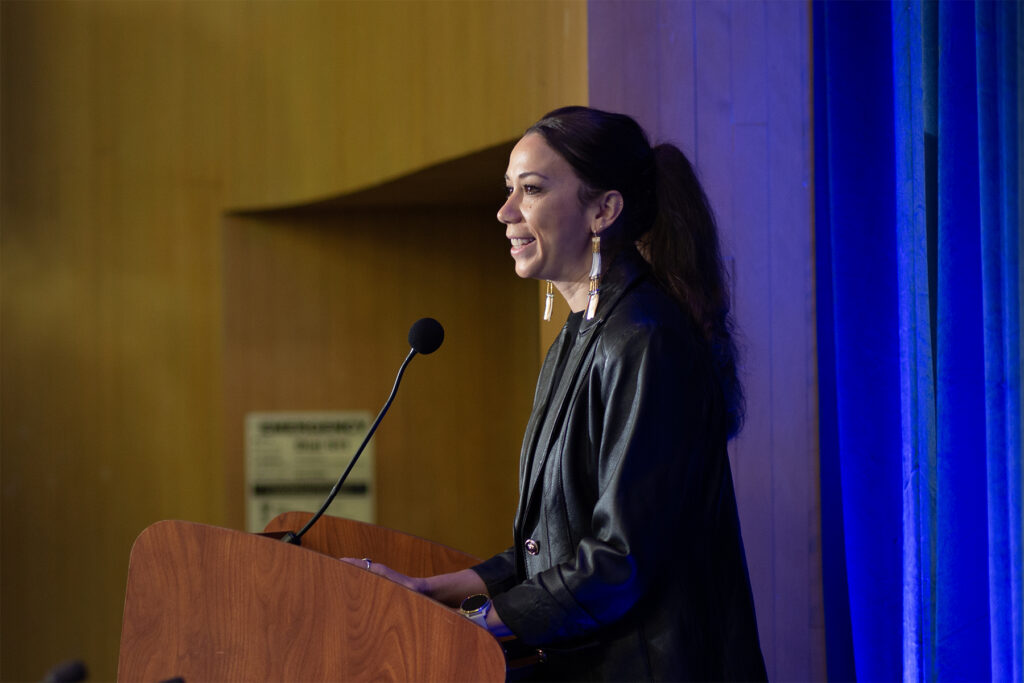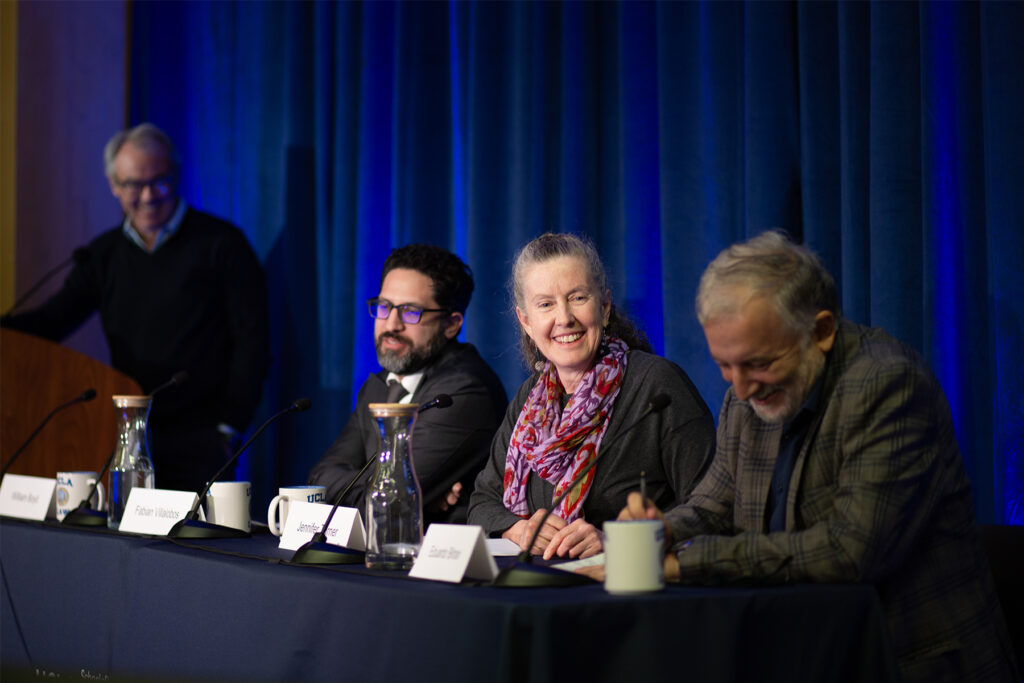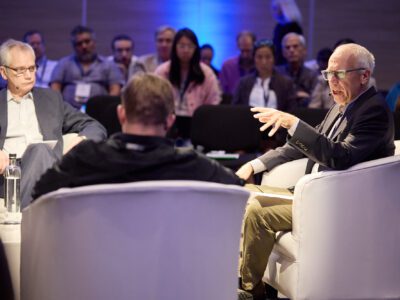Critical Insights on the Mineral Boom
In the race for critical minerals, the challenges, tradeoffs, and potential winners are becoming clear. Insights from the Emmett Institute’s “Powering the Future” symposium.

A couple hundred miles north of the Las Vegas strip at Rhyolite Ridge you’ll find a dusty yellow wildflower called Tiehm’s buckwheat that grows nowhere else in the world. But this flower sits atop a massive, untapped lithium reserve that would help the U.S. transition to cleaner energy. Now, what if you had to choose between approving this much-needed mining operation and preserving this unique flower?
In a way, you do have to choose. We all do. We’re in a race for lithium, copper, cobalt, nickel, and other critical minerals needed to move away from fossil fuels. Elected officials, policymakers, and courts are at this moment struggling to strike the right balance between that energy transition and the importance of biodiversity, Indigenous rights, environmental justice, and equity. This raises hard questions about what matters most to us, says Ernest Scheyder, who tells the story of the Tiehm’s buckwheat in his recent book The War Below. “And if we did nothing to address climate change and just left the flower there alone, would not the flower go extinct anyhow?” Scheyder was putting this to a packed audience of the UCLA Emmett Institute’s symposium “Powering the Future.”
There’s something about the fate of a single flower that focuses the mind, but of course there are myriad tradeoffs, community impacts, and geopolitical complications that are even messier to confront when it comes to critical minerals and the energy transition. These debates were the focus of the Emmett Institute’s all-day symposium on Friday, March 8 at the UCLA School of Law. The resulting panel discussions were fascinating, inspiring, and at times quite heavy. Over the next three days, my colleagues and I will be sharing summaries, outcomes, and insights here from the symposium. The keynote addresses and all three panel discussions can be viewed at our new YouTube channel.
“Powering the Future” Keynote Address
California Tribal Affairs Secretary Christina Snider-Ashtari gave the symposium’s keynote address and provided a crucial frame for the day’s discussions. As a member of the cabinet, the secretary leads the Governor’s Office of Tribal Affairs and oversees government-government consultation with California’s tribes. Snider-Ashtari is also an enrolled member of the Dry Creek Rancheria Band of Pomo Indians.
She started with a nod to California’s past. “Many of you may remember that the states’ origin myth is based on the discovery of gold—the shiny rock that would pave the way for the American dream for many,” Snider-Ashtari said. “The harder reality of that myth is that its discovery paved the way for… genocide. Native peoples were enslaved, relocated, and murdered in the American pursuit of gold extraction.”
California values and laws have come a long way since 1849 no doubt, but the adverse risks of a new gold rush remain. Snider-Ashtari cited one remarkable set of figures that would come up again and again during the day’s discussions: 97% of nickel, 89% of copper, 79% of lithium and 68% of cobalt reserves and resources are located on, or within 35 miles of, tribal land (according to the Indian Energy Minerals Forum). That’s one reason why some of the most significant legal battles over new mining operations have come from tribes, especially in the West and Southwest.

How then should the state of California, the U.S., and governments across the globe, pursue critical minerals without repeating the exploitative, violent practices wrought by previous extractive industries?
A first step, Snider-Ashtari said, is to acknowledge that societies still tend to reward exclusionary value systems. It’s incumbent on policymakers to make room at the table for vulnerable communities who will have legitimate concerns, requests, and demands. Time is of the essence, yes. Snider-Ashtari acknowledged that the climate crisis puts a shot clock on this process. But it is better to frontload these hard conversations, she suggested, rather than to delay those negotiations and hit an impasse further along in the process. “Given that this may be our one big push to shift global systems, it’s important that we embed space for diverse worldviews into the way that we move forward, and that communities asked to bear more of the burden on their ancestral lands and waters for the benefit of others are given voice, agency, and meaningful compensation in exchange.”
Panel One: The minerals we need and why
UCLA Law Professor William Boyd began Panel One with some staggering numbers.
An EV requires more than 6 times the mineral inputs of a conventional internal combustion car. An offshore wind plant requires 9 times the mineral resources of a natural gas-fired power plant. “Reaching the Paris agreement goals would require a quadrupling of mineral requirements for clean energy technologies by 2040,” he said. “To hit ‘net zero’ by 2050 would require six times more mineral inputs in 2040 compared to today.” Given this massive, and growing, demand, we are witnessing a global scramble. The goal of Panel One was to explain the state of the race.
Fabian Villalobos, Full Engineer and Professor of Public Policy at RAND Corporation, started the panel off with a presentation on the key technologies, minerals, policy drivers, and geopolitical issues in the context of critical minerals. A typical critical mineral supply chain has four components: extraction, processing, component manufacturing, and systems integration. There are all sorts of risks inherent in these supply chains, he said, but especially the lack of supply chain diversity with higher risk facing countries lacking domestic capacity in any or all four categories.
Jennifer Turner, Director of the China Environment Forum at the Wilson Center, next provided a discussion of the scale and scope of China’s dominance. Rather than start with the ongoing rush for minerals, Turner began “a long time ago in a galaxy far far away… in 2009” when the U.S. and China signed 9 key climate agreements to accelerate clean energy in those two countries—agreements that ultimately paved the way for the Paris agreement. Turner then argued that these collaborations have paid off big for air quality and climate but that the jury is still out as to whether collaborations can arise around critical minerals. “Guess what? China has won the race for critical minerals, there should be no question on that,” she said. That’s because China invested in mining 20 years ago, buying up E.U. and U.S. mining operations, and now has a mix of state-owned and private companies operating in China and around the world. BYD and other Chinese EV companies have big shares in mining and processing in Africa and South America. I came away from her presentation thinking that, perhaps, the race is for second place?
Next up was Eduardo Bitran, Professor of Economics and Member of Centro de Transición Energética at Universidad Adolfo Ibáñez in Chile. His presentation centered the experience of Chile, where he previously served as Minister of Public Works. “On lithium, we have the highest reserve in the world—37 or 36 percent,” he said. By contrast, the next largest producer is Australia with 24 percent of the world’s lithium. China meanwhile holds just 8 percent, he said, but has become the largest processor of lithium. China has also invested heavily in Chile’s lithium production, and yet more competition from the U.S. and E.U. would lead to a healthier market, he said. “We are facing monopsonistic risk or power through the Chinese capacity in lithium and of course this can affect the prices, affect the participation and the benefit of these products.” (Monopsonistic became the word of the day.)

The three panelists then were asked to participate in a series of lightning rounds where they responded in 2 minutes or less to the following questions, which I will try to do justice to here:
What is the most important thing China should do to ensure a just transition in regards to critical minerals?
Bitran said the Chinese approach to investment in other countries must change. The Chinese prefer to deal directly with the state and ignore other players, leading to political corruption, he said. Chinese market power is too powerful and diversification of demand is needed, he said. Turner added that the Chinese do have guidelines for green development they follow when operating in other countries but that they could go further. “They need to make their green Belt and Road Initiative, which is guidelines—they shouldn’t be guidelines, there needs to be some actual incentive, instead of voluntary measures for companies, there needs to be monitoring, requirements.” Villalobos focused on human rights.“They can start by working on their own domestic policies and actions, of course I’m talking about forced Uyghur labor,” he said. “There is a connection to resource extraction and Uyghur labor and if you want to ensure a just transition, not just globally, I think you should also address it at home.”
What is the most important thing the U.S. should do to ensure a just transition in regards to critical minerals?
Turner picked up Prof. Boyd’s iPhone several times during the panel to make various points including that the U.S. must get better about recycling the precious critical minerals in our devices to decrease demand for mining in the first place. “We need legislation and rules that are going to push the Apple folks to design products that are easier to be recycled because we could extract these, we could do what’s called urban mining,” she said. Bitran added that some American policies sure look like old-school protectionism and they need to be changed. “The Inflation Reduction Act’s tax is hurting Chile,” he said, noting that it is creating investment diversion. Subsidies and requirements in the U.S. are making Chile uncompetitive. One suggestion that arose: get rid of the ‘free trade’ clause, in the Inflation Reduction Act.
Fabian said the U.S. must leverage partnerships with allies, old and new. “If you want to be realistic about meeting any timelines to reduce carbon emissions you need speed,” he said. “At the same time you don’t want to depend on the current industrial base which is primarily China, which has all these environmental and labor issues that come with their practices in their country and elsewhere, so the US needs to leverage its allies and partners across the globe to include trad ones in developed country but also developing countries as well.” But Turner pushed back on that point to say, “Don’t leave China out in the cold, because China needs to be brought into these conversations too.” Turner then pointed to a successful climate cooperation called the U.S.-China Clean Energy Research Center, or CERC. That partnership developed clean energy technology and energy efficiency techniques involving NGOs and government. “A clean energy technology center for critical minerals,” is what’s needed, she said, “Work with the Chinese.”
What is the most important thing Chile, and other supply chain countries, should do to ensure a just transition in regards to critical minerals?
Bitran said that Chile should allow fair participation in setting rents on natural reserves, but more specifically should fairly deal with Indigenous communities around mining and the negative environmental impacts on their lifestyle and culture. Supply side countries must do more than just offer them money—America’s “casino approach”—but create a sustainable way of living with the new royalties, he said. “We should care about the next generation,” Bitran added. “At some point copper will not be there; lithium will not be there. What will be left there? We had that experience before with other minerals. We have to develop technology, knowledge, and suppliers that will turn into exporters.”
Conclusion
When the minerals are gone, what will be left? That question stuck with me throughout the day.
For one thing, these rich deposits of lithium, copper, nickel, and cobalt will at some point be depleted and mining companies will move on while residents and ecosystems remain. But in another way, I got to thinking about how long we will need so many critical minerals. With technology advancing as quickly as it does, how long before we no longer need such a staggering amount of minerals to build an EV or a wind turbine? For more than 150 years, the internal combustion engine has been king, leading to the (disastrous) rise of the fossil fuel industry. Chances are high that the energy technologies that are cutting edge now will not enjoy such a reign. Hopefully, we will make decisions to accelerate this energy transition and construct new global supply chains knowing that a transition is not permanent.
As for Rhyolite Ridge and that unique flower, decision makers are leaning toward the mine. Last year, the U.S. Department of Energy announced a $700 million loan to the company looking to build the lithium mine. And late last week, the Biden administration announced an even bigger investment in lithium mining in Nevada. The DOE plans to lend up to $2.26 billion to another company to build the Thacker Pass lithium project, pending environmental reviews. Construction will then take three years and eventually the mine will produce enough lithium to supply 800,000 EVs. In other words, the race is on, the contours are becoming clear, but we are still closer to the starting line than to the finish tape.
This is the first in a series of summaries, outcomes, and insights from the Emmett Institute’s “Powering the Future” symposium.
Reader Comments
One Reply to “Critical Insights on the Mineral Boom”
Comments are closed.






of course, the question of doing with less did not seem to be on the table. the implications of BAU are terrifying and the energy expenditures for all of these minerals seem unexplored. the second law of thermodynamics also seems an anachronism, though will not go away.